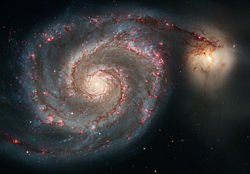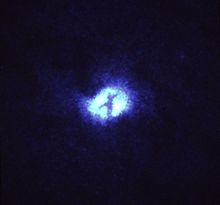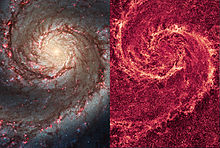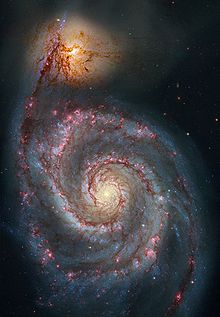- Whirlpool Galaxy
-
Whirlpool Galaxy 
Whirlpool Galaxy (M51A/B or NGC 5194/5). Credit: NASA/ESAObservation data (J2000 epoch) Constellation Canes Venatici[1] Right ascension 13h 29m 52.7s[2] Declination +47° 11′ 43″[2] Redshift 463 ± 3 km/s[2] Distance 23 ± 4 Mly (7.1 ± 1.2 Mpc)[3][4] Type SA(s)bc pec[2] Apparent dimensions (V) 11′.2 × 6′.9[2] Apparent magnitude (V) 8.4[5] Notable features Interacting with NGC 5195[6] Other designations Question Mark Galaxy,[2] Rosse's Galaxy,[2] M51a,[2] NGC 5194,[2] UGC 8493,[2] PGC 47404,[2] VV 001a,[2] VV 403,[2] Arp 85[2] See also: Galaxy, List of galaxies The Whirlpool Galaxy (also known as Messier 51a, M51a, or NGC 5194) is an interacting[6] grand-design[7] spiral galaxy that is estimated to be 23 ± 4 million light-years from the Milky Way Galaxy.[3] in the constellation Canes Venatici. It is one of the most famous galaxies in the sky.[8] The galaxy and its companion (NGC 5195) are easily observed by amateur astronomers, and the two galaxies may even be seen with binoculars.[9] The Whirlpool Galaxy is also a popular target for professional astronomers, who study it to further understand galaxy structure (particularly structure associated with the spiral arms) and galaxy interactions.
Contents
Discovery
What was later known as the Whirlpool Galaxy was discovered[10] on October 13, 1773 by Charles Messier, and is designated as M51. Its companion galaxy, NGC 5195, was discovered in 1781 by Pierre Méchain. It was however not until 1845 that the Whirlpool became the first to be recognized as a spiral. This was achieved by Lord Rosse employing a 72-inch (~1.83 m) reflecting telescope which he constructed at Birr Castle, Ireland. Sometimes M51 is used to refer to the pair of galaxies, in which case the individual galaxies may be referred to as M51A (NGC 5194) and M51B (NGC 5195).
In 2005 a supernova (SN 2005cs) was observed in the Whirlpool Galaxy, peaking at apparent magnitude 14.[11][12]
On 31 May 2011 a magnitude 13.5 type II supernova (SN 2011dh) was detected in M51 at coordinates 13:30:05.08 +47:10:11.2.[13]
Properties
With the recent SN 2005cs derived estimate of 23 Mly distance, and an angular diameter of roughly 11.2′, it can be inferred that M51's bright circular disk has a radius of about 38,000 light-years. Its mass is estimated to be 160 billion solar masses.
A black hole, surrounded by a ring of dust, is thought to exist at the heart of the spiral. The dust ring stands almost perpendicular to the relatively flat spiral nebula. A secondary ring crosses the primary ring on a different axis, a phenomenon that is contrary to expectations. A pair of ionization cones extend from the axis of the main dust ring.[14]
Visual appearance
Located within the constellation Canes Venatici, M51 is found by following the easternmost star of the Big Dipper, Eta Ursae Majoris, and going 3.5° southeast. Its declination is +47°, making it a circumpolar for observers located above 43°N latitude; it reaches high altitudes throughout the northern hemisphere making it an accessible object from the early hours in winter through the end of spring season, after which observation is hindered in lower latitudes.[citation needed]
M51 is visible through binoculars under dark sky conditions and can be resolved in detail with modern amateur telescopes.[9] When seen through a 100 mm telescope the basic outlines of M51 and its companion are visible. Under dark skies, and with a moderate eyepiece through a 150 mm telescope, M51's intrinsic spiral structure can be detected. With larger (>300 mm) instruments under dark sky conditions, the various spiral bands are apparent with HII regions visible, and M51 can be seen to be attached to M51B.
As is usual for galaxies, the true extent of its structure can only be gathered from inspecting photographs; long exposures reveal a large nebula extending beyond the visible circular appearance.
In January 2005 the Hubble Heritage Project constructed a 11477x7965 pixel composite image (shown in the info box above) of M51 using Hubble's ACS instrument.[15]
Spiral structure
The very pronounced spiral structure of the Whirlpool Galaxy is believed to be the result of the close interaction between it and its companion galaxy NGC 5195.[9]
Star formation
Induced spiral structure in the larger galaxy is not the only effect of the interaction. Significant compression of hydrogen gas occurs that leads to the development of starbirth regions. In pictures of M51 these show up as the bright blue 'knots' throughout the spiral arms.
Generally speaking, hydrogen gas is the most common component of the interstellar medium (the vast space between stars and planetary systems in galaxies). It exists primarily in its atomic and molecular form, and forms huge clouds throughout the entire galaxy. When large sources of gravitational pull pass nearby, such as other galaxies, gravitational interactions produce compression (density) waves that sweep through these hydrogen clouds. This causes some regions of the previously diffuse gas to compress into tight pockets of opaque and dense gas, these are dust lanes one so often sees in the spiral arms. In regions where the concentration and density of gas reaches a critical value, further collapse under its own gravitational pull occurs, and stars are born at the center of the collapse, where the gas is compressed so strongly that fusion initiates.
When this happens, these new-born stars consume huge amounts of gas causing them to expand, shine even hotter, and finally sweep away the surrounding layers of dust and gas by increasing efflux of the stellar wind. The gigantic proportions of the clouds out of which they are born means stars seldom, if ever, are created in isolation. Thus regions of several hot young stars emit sufficient light energy that they can be seen in the high resolution pictures of M51 across millions of lightyears distance.
For an example of such a formation in our own galaxy, see M16, the Eagle Nebula.
Companion
Decades ago, it was not known with certainty whether the companion galaxy NGC 5195 was a true companion, or another galaxy passing at a distance. The advent of radio astronomy and subsequent radio images of M51 unequivocally demonstrated the reality of the interaction.
Recent simulations bear out that M51's spiral structure was caused by NGC 5195 passing through the main disk of M51 about 500 to 600 million years ago. In this model,[16] NGC 5195 came from behind M51 through the disk towards the observer and made another disk crossing as recently as 50 to 100 million years ago until it is where we observe it to be now, slightly behind M51.
Galaxy group information
The Whirlpool Galaxy is the brightest galaxy in the M51 Group, a small group of galaxies that also includes M63 (the Sunflower Galaxy), NGC 5023, and NGC 5229.[17][18][19][20] This small group may actually be a subclump at the southeast end of a large, elongated group that includes the M101 Group and the NGC 5866 Group, although most group identification methods and catalogs identify the three groups as separate entities.[21]
See also
- Messier object
- List of Messier objects
- New General Catalogue
- List of galaxies
- NGC 5195 – the companion galaxy to NGC 5194
- NGC 5457 – another grand-design spiral galaxy
- M51 in Fiction
References
- ^ R. W. Sinnott, editor (1988). The Complete New General Catalogue and Index Catalogue of Nebulae and Star Clusters by J. L. E. Dreyer. Sky Publishing Corporation/Cambridge University Press. ISBN 0-933-34651-4.
- ^ a b c d e f g h i j k l m n "NASA/IPAC Extragalactic Database". Results for NGC 5194. http://ned.ipac.caltech.edu/cgi-bin/nph-objsearch?objname=NGC+5194&img_stamp=yes&extend=no. Retrieved 2006-12-06.
- ^ a b Takáts, K.; Vinkó, J. (2006). "Distance estimate and progenitor characteristics of SN 2005cs in M51". Monthly Notices of the Royal Astronomical Society 372 (4): 1735. arXiv:astro-ph/0608430. Bibcode 2006MNRAS.372.1735T. doi:10.1111/j.1365-2966.2006.10974.x.
- ^ "Distance Results for MESSIER 051". NASA/IPAC Extragalactic Database. http://nedwww.ipac.caltech.edu/cgi-bin/nDistance?name=MESSIER+051. Retrieved 2011-06-06.
- ^ SEDS.org (M51)
- ^ a b H. Arp (1966). "Atlas of Peculiar Galaxies". Astrophysical Journal Supplement 14: 1–20. Bibcode 1966ApJS...14....1A. doi:10.1086/190147.
- ^ D. M. Elmegreen, B. G. Elmegreen (1987). "Arm classifications for spiral galaxies". Astrophysical Journal 314: 3–9. Bibcode 1987ApJ...314....3E. doi:10.1086/165034.
- ^ Scalzi, John (2003). The Rough Guide to the Universe. Rough Guides. pp. 250. ISBN 1858289394.
- ^ a b c Nemiroff, Robert; Jerry Bonnell (2000-07-24). "M51: The Whirlpool Galaxy". Astronomy Picture of the Day. NASA. http://apod.nasa.gov/apod/ap000724.html. Retrieved 2007-04-22.
- ^ Charles Messier (1781). "Catalogue des Nébuleuses & des amas d'Étoiles". Connaissance des Temps [1784]. pp. 227–267 [246].
- ^ MacRobert, Alan M. (August 24, 2005). "Supernova in M51". Sky Tonight. Sky and Telescope. http://skyandtelescope.com/news/article_1544_1.asp. Retrieved August 7, 2006.
- ^ Bishop, David. "Supernova 2005cs in M51". supernovae.net. http://www.supernovae.net/sn2005/sn2005cs.html. Retrieved August 7, 2006.
- ^ Richard Kinne (kqr) (2011-06-03). "AAVSO Special Notice #241: New Supernova in M51". AAVSO. http://www.aavso.org/aavso-special-notice-241. Retrieved 2011-06-06.
- ^ "NASA's Hubble Space Telescope Resolves a Dark "x" Across the Nucleus of M51". News Center. HubbleSite. June 8, 1992. http://hubblesite.org/newscenter/newsdesk/archive/releases/1992/17/text/. Retrieved August 7, 2006.
- ^ "Out of This Whirl: the Whirlpool Galaxy (M51) and Companion Galaxy". News Center. HubbleSite. April 25, 2005. http://hubblesite.org/newscenter/newsdesk/archive/releases/2005/12/image/a. Retrieved August 7, 2006.
- ^ Salo, Heikki; Laurikainen, Eija (1999). "A Multiple Encounter Model of M51". Astrophysics and Space Science 269: 663–664. Bibcode 1999Ap&SS.269..663S. doi:10.1023/A:1017002909665.
- ^ R. B. Tully (1988). Nearby Galaxies Catalog. Cambridge University Press. ISBN 0-521-35299-1.
- ^ P. Fouque, E. Gourgoulhon, P. Chamaraux, G. Paturel (1992). "Groups of galaxies within 80 Mpc. II - The catalogue of groups and group members". Astronomy and Astrophysics Supplement 93: 211–233. Bibcode 1992A&AS...93..211F.
- ^ A. Garcia (1993). "General study of group membership. II - Determination of nearby groups". Astronomy and Astrophysics Supplement 100: 47–90. Bibcode 1993A&AS..100...47G.
- ^ G. Giuricin, C. Marinoni, L. Ceriani, A. Pisani (2000). "Nearby Optical Galaxies: Selection of the Sample and Identification of Groups". Astrophysical Journal 543 (1): 178–194. arXiv:astro-ph/0001140. Bibcode 2000ApJ...543..178G. doi:10.1086/317070.
- ^ L. Ferrarese, H. C. Ford, J. Huchra, R. C. Kennicutt Jr., J. R. Mould, S. Sakai, W. L. Freedman, P. B. Stetson, B. F. Madore, B. K. Gibson, J. A. Graham, S. M. Hughes, G. D. Illingworth, D. D. Kelson, L. Macri, K. Sebo, N. A. Silbermann (2000). "A Database of Cepheid Distance Moduli and Tip of the Red Giant Branch, Globular Cluster Luminosity Function, Planetary Nebula Luminosity Function, and Surface Brightness Fluctuation Data Useful for Distance Determinations". Astrophysical Journal Supplement 128 (2): 431–459. arXiv:astro-ph/9910501. Bibcode 2000ApJS..128..431F. doi:10.1086/313391.
External links
- StarDate: M51 Fact Sheet
- M51: Calar Alto Observatory
- SEDS: Spiral Galaxy M51
- NASA's APOD: The Whirlpool Galaxy in Dust and Stars (4/10/01)
- NightSkyInfo.com – The Whirlpool Galaxy
- Whirlpool Galaxy at ESA/Hubble
- The Whirlpool Galaxy (Messier 51(a)/NGC 5194)
- M51 The Whirlpool Galaxy
- The Whirlpool Galaxy on WikiSky: DSS2, SDSS, GALEX, IRAS, Hydrogen α, X-Ray, Astrophoto, Sky Map, Articles and images
Astronomical catalogs Messier: M49 - M50 - M51 - M52 - M53 NGC: NGC 5192 - NGC 5193 - NGC 5194 - NGC 5195 - NGC 5196 PGC: PGC 47402 - PGC 47403 - PGC 47404 - PGC 47405 - PGC 47406 UGC: UGC 8491 - UGC 8492 - UGC 8493 - UGC 8494 - UGC 8495 Arp: Arp 83 - Arp 84 - Arp 85 - Arp 86 - Arp 87 Coordinates:
 13h 29m 52.7s, +47° 11′ 43″
13h 29m 52.7s, +47° 11′ 43″Messier objects List M1 · M2 · M3 · M4 · M5 · M6 · M7 · M8 · M9 · M10 · M11 · M12 · M13 · M14 · M15 · M16 · M17 · M18 · M19 · M20 · M21 · M22 · M23 · M24 · M25 · M26 · M27 · M28 · M29 · M30 · M31 · M32 · M33 · M34 · M35 · M36 · M37 · M38 · M39 · M40 · M41 · M42 · M43 · M44 · M45 · M46 · M47 · M48 · M49 · M50 · M51 · M52 · M53 · M54 · M55 · M56 · M57 · M58 · M59 · M60 · M61 · M62 · M63 · M64 · M65 · M66 · M67 · M68 · M69 · M70 · M71 · M72 · M73 · M74 · M75 · M76 · M77 · M78 · M79 · M80 · M81 · M82 · M83 · M84 · M85 · M86 · M87 · M88 · M89 · M90 · M91 · M92 · M93 · M94 · M95 · M96 · M97 · M98 · M99 · M100 · M101 · M102 · M103 · M104 · M105 · M106 · M107 · M108 · M109 · M110See also  Book:Messier objects ·
Book:Messier objects ·  Category:Messier objects
Category:Messier objects  Portal:AstronomyCategories:
Portal:AstronomyCategories:- Spiral galaxies
- Unbarred spiral galaxies
- Interacting galaxies
- Peculiar galaxies
- M51 Group
- Canes Venatici constellation
- Messier objects
- NGC objects
- UGC objects
- PGC objects
- Arp objects
Wikimedia Foundation. 2010.




